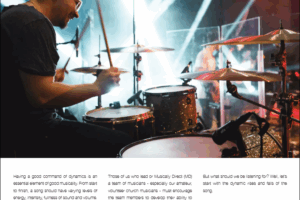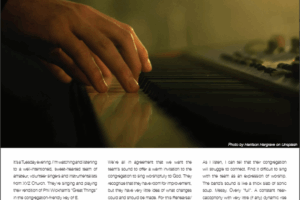Take this link to read Grant’s article as featured in the July issue of Worship…

BETTER BAND PREPARATION: DEFINING SOUND CHECK & REHEARSAL
By Grant Norsworthy
Ask just about any Musical Director of a Church ensemble (band, choir, orchestra, whatever) and they’ll probably tell you that it’s the commodity of time that is in the shortest supply. There never seems to be enough time to prepare to the level that we want!
Maybe you get your team together for only 30 minutes right before the Sunday morning service. Perhaps you have 3 hours on a weeknight and another hour on Sunday morning. Something in between? Whatever your situation, there are some simple changes you can make that will bring dramatic gains to the efficiency and effectiveness of your available preparation time. The results will surprise you.
The biggest gains will come in two main areas:
- Stronger, better leadership from the Musical Director (MD)
- Maintaining a team culture that has clearly understood terms and goals
Drums, bass, electric and acoustic guitars, keyboard and several vocalists. This seems to be the most common contemporary ensemble for Church services these days. That’s the ensemble that I am most experienced with, so I’ll be using that contemporary band in my examples from here. But these principles apply for other types of ensemble as well.
After set up, there are five things you can do with a band:
- Jam
- Practice
- Sound Check
- Rehearse
- Implement
One of the main problems I observe as bands prepare music for a service is that each of these five terms is not well understood by the band members. Often the MD has only hazy definitions too! Certainly the distinction between these, and the correct time and place for each is poorly communicated by the leader.
As a result, preparation time is often a messy, hodgepodge of setting up, jamming, practicing, sound checking and rehearsing. Frequently, I see teams trying to do two or more simultaneously! Predictably, each is done poorly and inefficiently. Huge chunks of our precious preparation time slip through the cracks as a result.
Does this scene sound at all familiar to you?
We were supposed to start rehearsal at 7. But even though it’s now 7:20, …
- The bassist has headphones on listening to the songs (for the first time) from his phone and fumbling through the arrangements as best he can.
- The electric guitarist is ripping out Van Halen’s “Eruption” at full volume – just because he can!
- The drummer’s kit is still without cymbals and she’s trying to locate the sticks bag.
- Competing with the general din, the acoustic guitarist is in a yelling competition with the audio engineer to try and work out why there is no signal from his instrument.
- The keyboardist waits expectantly for direction from the MD, blissfully unaware that the chord chart in front of her is a different arrangement and in a different key from the charts that are in front of every other member of the band.
- The vocalists are doing exactly what vocalists do when they have not been directed to do any differently – chatting amongst themselves about their day, their week, life in general. It’s a singer’s version of jamming.
We haven’t even started our rehearsal! Is it any wonder that time runs short?
So, let me define the 5 terms – the 5 things you can do with a band – so that the leader can communicate each to the team members and establish and maintain a team culture that agrees to stick with these definitions and make them a priority.
1. Jam
In the jazz world, jamming has a more specific definition. But for our purposes, jamming is musical fooling around. Playing your instrument as you feel and just for the fun of it on your own or with others. Jamming is a great thing to do. Important in the development of every instrumentalists. But, unfortunately, there is no time to spare for jamming during our preparation. Make another time to jam but, please, not now.
2. Practice
To many musicians, the words practice and rehearsal are synonymous. But they are not! To quote Jon Nicol from www.WorshipTeamCoach.com, “Practice is personal. Rehearsal is relational.” We do not have time for practice while we are together. Prior to us getting together, each individual needs to have invested time and energy in personal practice so that they come fully prepared for rehearsal with the other team members. They need to know the song well (not just one or two listens!) and be confident in their own parts for the entirety of the song and how they will fit with the other musical elements. Don’t call your rehearsal a practice. Don’t practice in your rehearsals.
3. Sound Check
I am staggered by how few Church bands have a sound check; especially a sound check with a definite start and end, using a specific system and with explicit goals. We must!
Our sound needs to be checked both for Front of House (FOH) – in the main auditorium – and the monitor system for the singers and instrumentalists on the platform. If you have the same set up and line-up as the last time the band was together, perhaps just a shorter line check is necessary. In either case, a clearly started and completed time for checking sound – without anything else happening at the same time – is an essential prerequisite for quality preparation.
During the sound check, the MD – in close collaboration with the audio technician – should lead the band to systematically isolate each individual sound source. Each microphone and DI signal is heard on its own so that it can be checked for level, quality, clarity, equalization and (in some cases) effects and panning. After checking every sound individually, a short section of a song should be played together (like the chorus of a well-known, louder song) to check the sound blend – especially the levels in relation to one another. Adjustments can be made and then, with one more blow through the chorus, the sound check is completed and we can move on to rehearsal.
If you’re not in the habit of doing sound checks, they might consume a big chunk of your available time, but only to begin with. Do it every time you get together, with a good, well-understood system and strong, clear leadership. It will solve a myriad of problems and save mountains of time in the long run.
4. Rehearse
Our relational rehearsal is only possible after adequate personal practice from all band members. Distinct from practice, rehearsal is bringing together all the individual instrumental and vocal parts to make a good fit, smooth off any rough edges, to polish the final product. In theatre language it’s a “dress rehearsal”. Rehearsal is NOT the time for individuals to practice their parts, work out song structure, discover that we need to be in a different key, negotiate who’s going to play the intro’s melody hook, or decide that we’re going to model our version of the song on artist B’s version rather than artist A’s. That all needs to have been decided and well communicated by the MD way before rehearsal.
5. Implement
Finally, we get to use what we have prepared to engage the Church congregation – to facilitate them singing songs as an expression of worship to Almighty God. I use the word implement here instead of perform, intentionally. We implement the music in such a way as to invite the congregation to join the band as, together, we sing praises, prayers and reminders of God’s truth – to encourage one another and to show our adoration to Him. We have not practiced, sound checked and rehearsed so we can perform for an audience of people. We have done these things to help our Church family to know more of God’s grace and to worship Him through songs – recognizing that He is the audience.
So, with no more jamming or practicing going on during your precious minutes of preparation before implementation, you’ve just saved, perhaps, 50% of your time! Put it to good use! Let’s lift the standard.
But here’s the clincher: The set time for the start of rehearsal is not – should not – be the time to arrive for rehearsal. It is the start time for sound check that flows immediately into rehearsal. Any set-up must be done before the start time. In Nashville, they say “downbeat at [time]”. If downbeat – the start time for sound check – is 8 am, the audio engineer might need to be there at 7:15. The guitarist who brings their own amp, pedals and so on might arrive at 7:30. Vocalists might walk in at 7:58. But we’re all there, ready to go at 8 am.
Please understand: All this explanation of WHAT to do and HOW to do it only makes sense if your team first understands and agrees WHY we have music in our Church gathering and WHO it is really for. If you’re not sure what I mean, read this Blogpost on the subject.
Communicating WHAT and HOW your team should prepare – making practice personal and plentiful, being set up on time, having focused sound check and rehearsal – gets a lot easier if we first agree on WHY and FOR WHOM we have music.
This article was first published by Worship Tech Director of the WFX Network on September 15, 2017.


